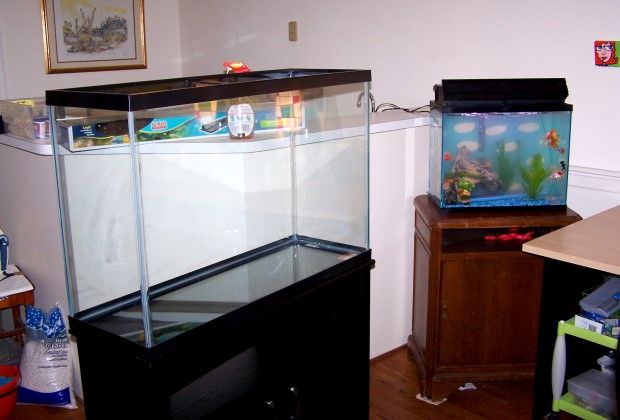
Buying a goldfish tank that is large enough and designed to house the number of goldfish you plan to keep is the first step to raising healthy fish that thrive. The type of aquarium you choose can determine whether your goldfish flourish or just barely survive.
You want a goldfish tank that your fish can comfortably live in.
Goldfish can live for 15 to 20 years, and some have even surpassed the 20-year mark. But to ensure your goldfish reach adulthood, it’s important that you choose goldfish tank your fish will thrive in.
Remember that your goldfish will grow rapidly and will not be an inch long for very long, so you should plan on a larger aquarium to start. – Quick & Easy Goldfish Care by TFH Publications, Inc.
Then there’s the matter of design. Tanks aren’t just the traditional rectangle shape now. You can get fancy and buy a dazzling aquarium specially designed to enhance the beauty of your goldfish.
Let’s take a look at a few goldfish tank requirements, what to avoid, and how to pick the best option for your aquarium needs.
What Size Is Appropriate for a Goldfish Tank?
Get 20 gallons (75 liters) at the very minimum and only if you’re keeping one or two goldfish.
We’ll get to why in a minute, but you don’t want an aquarium smaller than that. Depending on how many goldfish you plan to keep, chances are you’ll want a tank much, much larger.
Yes, I know. Goldfish tanks are expensive. But on the flip side, your goldfish won’t have to breathe through murky water. Assuming the aquarium is properly maintained, of course. And it’s much easier to keep the water crystal clear in a large goldfish tank.
No matter which way you look at it, a small aquarium equates to much more work, frequent water changes, and stressed out goldfish.
In addition to those 20 gallons, you’ll need to add 10 gallons (40 liters) of water for each additional goldfish you buy (if they’re fancy). If you’re keeping slim-bodied goldfish (like commons, comets, or shubunkins), you’ll need even more space – 30 gallons for each additional fish. Take a look at my guide on common goldfish types.
But why all the space?
I’m sure you’ve heard of the one-inch-of-fish-per-gallon rule. But goldfish aren’t like tropical fish, so this rule just doesn’t apply.
Instead…
Buy the Biggest Tank You Can Afford
There are a number of reasons for this. Let’s look at a few.
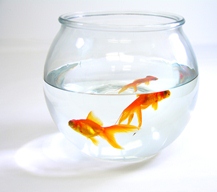
- Goldfish are very bulky. Because of their odd body shape, they need much more oxygen than slim-bodied, more streamlined fish of the same length. Yes, the one-inch rule might work while your goldfish are young. But as your goldfish grow (and grow quickly), so does their body. Before you know it, your goldfish are quadruple the weight they were previously. And because they’re so heavy, they’ll need even more oxygen. If your tank doesn’t have a lot of space with a wide surface area, you may find your goldfish gasping for breath near the water line. Goldfish bowls are especially harmful because bowls usually have a very tiny surface area with no room for a filtration system.
- A large tank gives your goldfish plenty of room to grow to their full potential. In a small 5-gallon aquarium, your goldfish will still grow. But growth will become stunted, and your goldfish won’t be able to develop properly. In such an environment, goldfish usually don’t last any more than a couple of years. Sadly, many goldfish never live long enough to even grow the 8 inches, 10 inches, or even 20 inches long their body was destined to be.
- Water changes can be very stressful in a small goldfish tank. Goldfish prefer water that maintains a constant temperature. A small aquarium just can’t hold enough water mass. The water will take on whatever temperature the room is, heating up or cooling down much faster than a larger goldfish tank with more water mass (more water allows for slower temperature changes). If someone happens to leave the window open or the power fails and cold air flows into the room, the quick temperature change will cause your goldfish serious stress. And if you’re doing a routine water change (small tanks require more frequent changes), your goldfish can go into shock if you aren’t careful to keep the newly added water the same temperature as the tank.
- Goldfish excrete tons of waste. More waste than most other fish species because of their heavy bodies. So every day that you let your goldfish tank sit, the water quality is getting worse and worse. When you change the water, you’re bringing the water quality back up to its original state. Because larger goldfish tanks have more water mass, the quality of the water decreases slower. Wastes are less concentrated. That’s why you won’t have to do as many routine water changes (or take out more water per change) to keep conditions healthy in a large aquarium. With a 5-gallon tank, you’ll probably have to change the water every day, taking out half of the water per change depending on how many goldfish you have (and how poor water quality is). If you’re late to change the water for whatever reason, your goldfish can quickly become sick.
- The bigger the tank, the less crowded it will be. Overcrowded tanks can cause serious health issues. Water quality worsens at a much faster rate as more waste dissolves and the water becomes more concentrated with harmful toxins. Fish also get more aggressive when they’re overcrowded. So not only are your goldfish stressed out from the poor water quality, but they’re now faced with aggressive tank mates. If they don’t suffer from a few bloody scrapes or torn fins first, a fungal infection is bound to rear its ugly head later.
- Your goldfish tank will fall short. We all have an idea of how we envision our goldfish tank to look like once everything is all set up and running properly. Some fish hobbyists might want to go all out, landscaping the aquarium with all sorts of live plants, pieces of driftwood, and gorgeous waterfall ornaments. Others might want a more simplistic look – a few plastic plants and maybe a treasure cave in the center with holes for hiding. Whatever you envision your goldfish tank to look like, chances are that you won’t be able to achieve the same look with a small aquarium. You’ll want to go much larger, and for some, this may even exceed the 20-gallon requirement.
- You’ll probably want to keep more than one goldfish. Two goldfish can’t thrive in a tank less than 20 gallons. And depending on the type of goldfish you’re keeping, you may need even more space than that. Besides, goldfish are social creatures and prefer the company. So consider how many goldfish (and which goldfish types) you want to keep before buying your goldfish tank.
Even with a large aquarium, you still don’t want to max your tank to capacity. Your goldfish will be a lot happier with a few gallons of extra space. So if you plan to keep four fancy goldfish, you might want to buy a 50-gallon tank, instead of a 40-gallon. Or even a 46-gallon bowfront aquarium.
Buy the biggest tank you can afford. You’ll be happy that you did.
Long or Wide?
Aquariums come in many different shapes and dimensions.
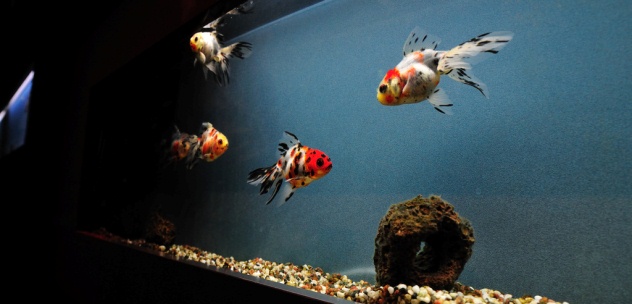
The shape you choose should be carefully considered, since not all of them offer your goldfish the same benefits. Avoid equilateral hexagons, pentagons, and cylinders. These aquariums are usually too deep, and they don’t have a wide surface area like rectangle or bowfront aquariums.
Stay away from long, deep tanks. Goldfish are oxygen hogs and need the extra surface area in wide, horizontal setups. A wide surface area (the space at the top of the aquarium where water meets air) is crucial to keep oxygen levels up and carbon dioxide out. Long aquariums are also harder to work with, since you’ll have to reach far to move around ornaments or plants.
Besides, goldfish are much happier swimming across distances than they are swimming deep.
Acrylic or Glass?
Whether you buy an acrylic or glass aquarium is up to you. Both options have their benefits and disadvantages. Neither one is perfect.
Let’s compare the two.
Acrylic
- Acrylic aquariums are lightweight. In fact, if you take both a glass and acrylic aquarium of the same size and shape, the acrylic tank will be noticeably lighter. That’s because acrylic material is less than half the weight of glass. So you can move much larger acrylic tanks with less effort (and the floor and aquarium stand can more easily handle the weight).
- Acrylic aquariums are very durable. You don’t have to worry about major leaks from cracks or breaks. If there is some sort of collision (your kids are playing ball near the goldfish tank), the aquarium will just bend a little, depending on the force of impact. And since acrylic tanks are bonded rather than seamed together, they hold up better over the long term.
- Acrylic aquariums retain more heat. As you know, fluctuating water temperatures will stress out your goldfish. So by retaining more heat, the tank is able to keep the water temperature more constant.
- The sides of acrylic aquariums are spotless. They don’t have seams or silicone filled corners like glass tanks do (not only can seams take away from the visual appeal, but your goldfish tank can also leak if a seam gets damaged).
- Acrylic aquariums offer a clear, realistic view. The view isn’t as distorted as it is with glass. There’s also no green tint in acrylic material, as there is in some glass aquariums.
- Acrylic aquariums have more design options. You don’t have to stick with a plain rectangle-shaped tank. Enhance the beauty of your goldfish tank with a flat back hexagon or bowfront aquarium.
- Acrylic aquariums can scratch if you’re not too careful. But scratches can also be easily removed. A scratch is also much better than a crack (and potential leak).
- Acrylic aquariums can be a bit pricey. Often, you’ll find the same sized glass aquarium at a cheaper price.
Glass
- Glass doesn’t scratch. But it can break. And then you’re faced with a massive leak.
- Glass aquariums can hold their shape, even if unsupported. If you don’t support the whole acrylic aquarium on a stand, the material can bend over time.
- Glass aquariums maintain the same clarity for years. If you buy an acrylic aquarium made without UV stabilizers, it can yellow or cloud as it ages. Always check to make sure the brand you buy uses this technology before going acrylic.
- Glass aquariums are heavy. Many people recommend acrylic for goldfish tanks larger than 300 gallons, because by that point, glass just becomes too ridiculously heavy to lift (and you’ll need special equipment to even carry the empty aquarium past your front door). The extra weight is also a strain on your aquarium stand and floor.
- Glass aquariums have seams on the corners. Seams can often be damaged while scraping algae off the sides of the aquarium. And if a seam does get damaged, you may have a serious leak on your hands.
- While still clear, glass can have a green tint. This is from the iron in the glass. The more iron the glass has, the greener the tint. And so thicker glass aquariums usually have a greener tint than thinner ones.
- Glass design options are limited. You’ll usually only find glass aquariums in the traditional rectangle shape. But since these aquariums are rectangular, surface area is maximized to provide your fish with better aerated water.
The goldfish tank you choose is up to you. Either an acrylic or glass aquarium will do. But remember: Always buy the biggest aquarium you can afford. Make sure it’s wide (from left to right) and not long (top to bottom). Goldfish need the space to thrive. The more surface area your aquarium has, the better aerated the water will be.
Which Goldfish Tank Do You Prefer?
Do you buy glass or acrylic? What sized aquarium do you have? How many goldfish do you keep? Share your thoughts in the comments below!

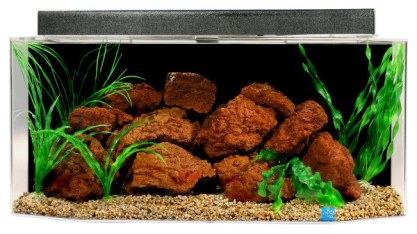
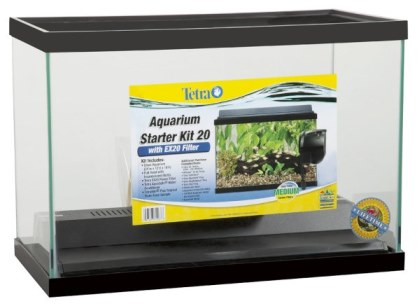


71 comments
Hi Christina,
I really like reading all the info you have here.
I started with a 20 gallon tank and three goldfish for my young kids. Now the fish are 3 years old with 4 1/2-5 inch bodies in a 40 gallon tank. The tank has a bio wheel and air stone with a gravel bottom. I thought enjoy the fish and taking care of the tank. I think this is becoming my hobby(to my wife’s dismay). My problem has been with some plecos in the tank. The first pleco went in with the goldfish in the 20 gal tank and just recently died. I replaced him with two smaller younger plecos. The first replacement died inside a week, and then HIS replacement died about week later. The second of the two smaller younger plecos died in just under two weeks. I test my water every Friday and do a 20% water change every two weeks. I am REALLY bummed as I have now lost 4 total plecos in about a month! Now I’m a little scared to get another pleco cuz I’m almost positive it will die! Would like any advise you might be able to offer.
Thanks
Greg
I have a 100 liter cement fish tank , I have put up natural sand and gravel in it , to look more natural like a pond , I change the water every 15 days , but the only problem is that I have 12 fancy,3 long tailed , 2 black , 8 white gold fishes in it . So is it overcrowded ????
OMG. the things that i have learned about gold fish are starting to take their effects on me. im probably more stressed out than the gold fish, i did every thing wrong. I have a black moore and 2 comets living under the same 10 gallon tank ( 2 mistakes already ) im at work right now but i will be going home imediatly to correct the problem. “FISH STORE HERE I COME” My poor babies , im such a bad daddy =(.
I have a 46 gallon bowfront with a 93 (approx) gal canister filter. I have one black moor and one telescope. They are both around 4.5 inches, and I planned to only have two. Now I reeeallly want one more fish.
Is this inadequate for 3? Or dangerously close?
Hi,
I have a 5 gallon tank, and I want a black moor gold fish, I was wondering if this would be ok. if not i’m not a huge fan of neon tetras, are there any other fish that would work?
Hi,
I have three gold fish one that is 4 inches from head to tail but has long fins and tail,small body, the other one is 5.5 inches has long tail big body and medium fins. The third on is 2.5 inches short tail short fins but big body.I have a 5 gallon tank that I put them in during winter and I have them in a pond in the summer. They grow bigger each year at least 1 to 1.5 Inches. What kind of gold fish are these and what size tank should I put them in. Also I have had these fish for 7 years. These fish out lived all the other fish even my second gold fish which was a birthday present from my father. He lived 6 years before dying. I want to be able to keep them healthy and to reach maximum age.
I have 2 goldfish about 6 inches long each and a 28 gallon tank. I am wanting to put them in a 55 gallon tank. I preferred to get one it is 48 inches long.
Dilemma is this: we want to get a BROWN cabinet for a tank about 55 -65 gallons but can only find one that is 3 feet long and 24 inches tall and 12 inches wide.
Do you have any idea where we can get a brown ( not black) cabinet that would accommodate a 48 inch length And not too tall?
Thanks!
I have an 11 yr old feeder fish. He is only in a TWO GALLON plastic tank with NO filter. I feel awful as I learn this, but I’m too afraid to move him because I’m confused about what exactly to do……cycling, filters and killing him with too many changes??? Help please. 1. Do I change the size gradually?2. Do I have to cycle a new tank? 3. He’s not used to a filter, (and neither am I) is it ok if he has one after 11 years? Will glass be ok if he’s used to plastic? He has always been happy (I thought :-/ and friendly…. I don’t know if I should fix what’s not broken…..but it seems I’ve given him a terrible cruel life when I read this. I have 4 furry pets too, and understand their care much more. I would appreciate not terribly drastic suggestions. Thanks
I never new goldfish needed that much space! I just moved my 7 year 11 month old goldfish from a 5.5 gallon tank to a 10 gallon tank. That’s the biggest tank I can afford. Is that ok for my one goldfish?
A 10 gallon might work temporarily, as long as you’re vigilant – pay careful attention to ammonia, nitrite, and nitrate. Test the water regularly (weekly or more often if there’s a water quality issue). Ammonia and nitrite should never go above 0ppm (parts per million) in an established tank, though you should keep nitrate under 40ppm. You can view my article on aquarium test kits if you need help with this.
Years ago, I managed to keep a goldfish quite healthy in a 10 gallon tank with a good power filter and sponge filter combo and frequent water changes every few days – though you can also add an air stone for added oxygen. Though maintaining water quality in an overcrowded goldfish tank can be a lot of work. Eventually, you’ll want to save for a larger aquarium – at least a 20 gallon.
My tank gets cloudy pretty quick, maby in a week. It used to stay very clear for at least a month. My tank came with a filter pump, the kind that only circulates the water with a replaceable filter. If I added a pump that pumps air bubbles in the tank, would that help to keep the tank clear?
Hi Eugene,
The cloudiness you’re noticing sounds like it might be a bacterial bloom. This is common after a new tank is set up, before the nitrogen cycle has a chance to run its course. There could also be a buildup of waste in your tank.
Have you tried testing the water for ammonia? If you’re running an established tank, your problem might be caused by overfeeding or overcrowding – both of which can elevate ammonia to unhealthy levels.
I recommend sweeping the gravel with a water siphon to remove any built-up waste that might be hidden underneath. If overfeeding is a problem, definitely reduce feeding sessions or decrease the number of times you feed your goldfish. The pump might help boost oxygen levels – since it’s likely the bacteria is hogging most of the oxygen. But the pump alone won’t reduce the cloudiness, though it may make it easier for your goldfish to breathe.
It sounds to me like you might have a water quality issue – definitely test for ammonia if you haven’t already. But if you just added aquarium substrate, poorly washed gravel might be the cause. In this case, a water clarifier might help (I’ve used the Aqueon Water Clarifier with good results).
I just recently bought a 10 gallon tank and 4 comet goldfish. Before you chew me out, I now know they grow much larger. I am not sure what to do, will 4 be okay for now? Any help would be appreciated.
Hi Elizabeth,
A 10-gallon tank might be okay *as long as* you carefully monitor the water for ammonia, nitrite, and nitrate. In overcrowded tanks, it’s common for ammonia and nitrite to quickly get out of hand – so keep those test kits handy and check water parameters every few days until you can buy a larger aquarium. Ammonia and nitrite should always be at 0ppm (parts per million) in an established aquarium, while you should keep nitrate levels below 40ppm.
If you’re struggling with this, it’s time to get a larger tank. Your goldfish will eventually outgrow the 10 gallon. It might also help to add a couple air stones or get a sponge filter to keep up oxygen levels if you notice your goldfish spending a lot of time at the water surface. But a new aquarium should take priority.
i have a 46g bow with a 7 (without fins) inch common and a 5 inch koi. i added 11 feeder comets. i change the water 50-75% every week. is this harmful?
Hi Alyssa,
A 46-gallon bowfront aquarium is pretty small for housing 13 goldfish, especially two nearly fully grown. A 50-75% water change every week might be okay, as long as pH doesn’t fluctuate too drastically and the water temperature is the same as the temperature in the aquarium.
Are you just housing the 11 feeder comets in there temporarily? I’d definitely recommend keeping an eye on those water parameters.
ok so I have one goldfish in a 1.5 gallon aquarium. It recently had ich but I think it’s fully cured. is my aquaru a death trap waiting to happens bcs of it’s capacity? it isn’t a fancy goldfish, keep in mind. I won it at a carnival and it’s either been referred to as a comet goldfish or a feeder fish. please help I’m really worried
Hi, hopefully this message doesn’t come to you too late. Sadly, I strongly don’t recommend a 1.5-gallon aquarium. That’s much too small, especially for a comet goldfish. You’d be better off getting a 20-gallon tank at the very least – preferably 30 gallons if you can.
Until then, I highly recommend testing the water frequently for ammonia and nitrite. Ammonia and nitrite should always be 0ppm (parts per million) in an established tank. It’s common in small tanks for ammonia to build up – and high ammonia and nitrite levels can be deadly. If ammonia or nitrite levels don’t reduce after several water changes, you’ll have to upgrade to a larger tank very soon. A goldfish won’t survive very long in poor water conditions.
You can read more about water testing in this article.
I just recently one 2 goldfish from a fair and lost one tonight, I already called Petco and they informed me the other would die also due to where I got them but its no been 4 hours since the first passed and he’s still swimming and kicking. He also told me of water conditioners, do those really help? Should I get one? My tank was a fast buy on second hand and is a hexagon. I got a new power filter for 5-10 gallons(Petco recommended).
Hi Erica,
Did you test the water recently for ammonia and nitrite? You might have a water quality problem if you’re using a 5-10 gallon tank. I always recommend 20 gallons minimum for one goldfish.
Goldfish also need a good filter to keep up with all the waste they excrete. If you’re using an external filter, make sure it has a flow rate (gallons per hour or gph) that is at least 10 times your tank volume. A 20 gallon tank will need a filter that has a 200 gph flow rate at least – more is fine too, as long as the filter sits comfortably on the aquarium and the water flow isn’t too harsh for your goldfish to swim through. Use this guide if you need help pinpointing the cause of death.
As for water conditioners – I always use a water conditioner whenever I add new water to the aquarium. I use tap water in my tanks, so the water conditioner helps neutralize harmful metals and chlorine present in tap water that can potentially kill fish (I did lose some fish to tap water when I was first starting out). You can read more about how water conditioners work in my guide here.
I won 3 little goldfish from the county fair. What type of goldfish are they? And what size tank do you recommend for me?
Hi Natalie,
It’s hard to say what kind of goldfish you have without any photos of them. But I’m betting they’re comets – these type of goldfish are pretty common, especially in feeder tanks.
If you do have comet goldfish, you’ll want a 70-gallon tank or pond to house all three. 3 fancy goldfish will only need 40 gallons at the very minimum.
If your goldfish are still small, they might survive in a smaller tank for a few months before you have to upgrade to a larger one. But one way to determine if your aquarium is overcrowded is to test for water quality. You can get ammonia and nitrite test kits for about $10, and you’ll want both tests to read 0ppm (parts per million). If you have trouble reducing ammonia and nitrite with water changes, your tank is overcrowded. For more information about water parameters, see this guide.